NEETS BAY BEAR CRUISE
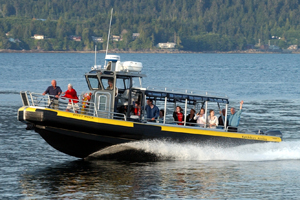
|
 |
|---|
|
This is Neets Bay, home of one of the largest salmon hatcheries in the world. Every summer beginning in mid-July bears gather in Neets Bay waiting for the salmon to return from the ocean to spawn. Bears love to eat salmon. By eating plenty of salmon during the summer the bears are able to sleep comfortably through their winter hibernation. We take you to Neets Bay in a 34 foot boat called the West Rock. The boat ride from Knudson Cove to Neets Bay takes about 45 minutes. Our search begins in the outer part of the bay where the younger bears and mothers with cubs can be found. Scattered throughout the bay are several small salmon streams. This is where young bears learn how to fish without getting in the way of older bears which prefer to fish near the hatchery itself. If we spot a bear near one of these streams we will slow down and ask everyone to be very quiet. Bears don't have very good eyesight so even in these more natural settings we are often able to bring the boat very close to them - if we're quiet. Bears fishing near the hatchery are accustomed to people and have no fear. When we arrive at the hatchery you will see there is much activity. Floatplanes come and go. Fishing boats are setting their nets and the hatchery is busy collecting over 100 million salmon eggs to propagate the run. |
|
|---|
 |
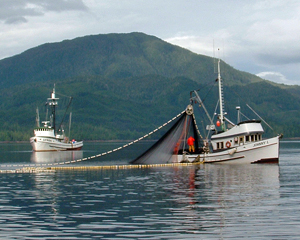 |
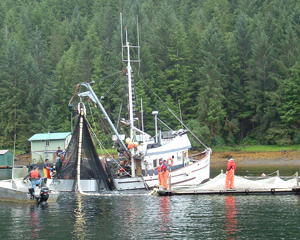 |
|---|
 |
 |
 |
|---|
 |
Like people, bears have different personalities and do as they please. Some bears are very curious and allow us to get quite close. Others are more shy. Most bears just ignore us when they are busy fishing near the hatchery. "Griz" (upper left) was an orphan and weighed less than 50 pounds when we first saw him in 2007. He actually swam out toward boat and wanted to get in with us. This year he was about 100 pounds but still not large enough to move among the bigger bears. |
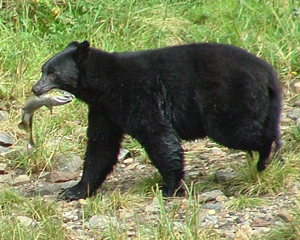 |
|---|
 |
|---|
 |
The tide in Neets Bay can rise and fall as much as 22 feet in just 6 1/2 hours. When the tide is high we can go right up near the hatchery itself. When the tide is low we see more bears out on the mud flats, near the creek mouths and along the shoreline. |
 |
|---|
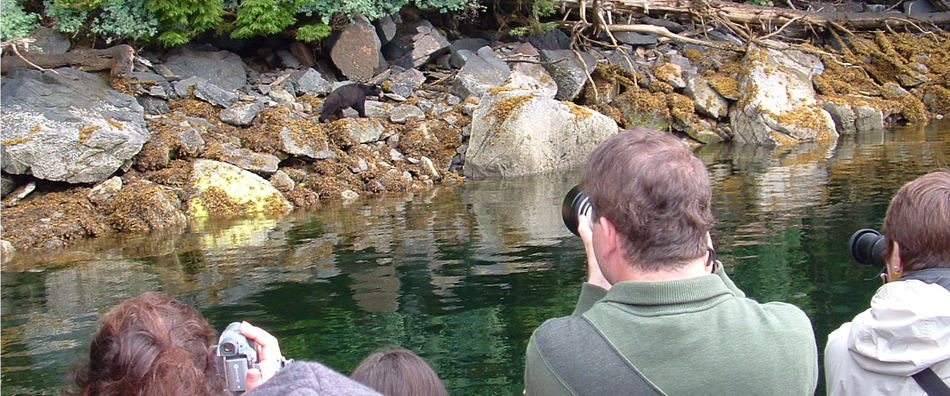 |
|---|
 |
 |
 |
|---|
 |
The bears can be seen fishing at any time during the day. After catching fish for an hour or two they go back into the woods to take short naps. Sometimes there is not a bear to be seen when we arrive. Then they start coming out again. One bear is often followed by another. |
 |
|---|
 |
These two bears are yearlings fending for themselves. There were no salmon in the stream at the time so they were busy turning over rocks and eating small crabs. Bears are born in late winter while their mothers are still in hibernation. They will spend the first summer and one more winter with their mothers and then leave their mothers the following spring. Siblings often stay together until late in their second summer. |
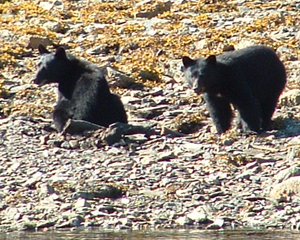 |
|---|
 |
 |
|---|
Every year we see a number of mother bears taking their cubs on long hikes. Black bears have 1-4 cubs every 2 years. Smart mothers will keep their cubs away from larger bears for a few months. It's fun watching the cubs trying to keep up with mom. |
 |
|---|
 |
When there are plenty of fish the bears don't mind fishing right next to each other. |
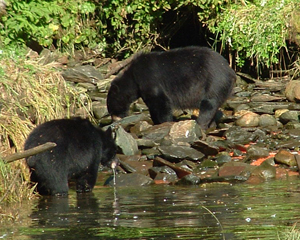 |
|---|
 |
This is a larger bear. Even though it's mid-summer his coat is still very thick. That's because it never got very warm last year. When it gets too warm the bears will rub the fur off their hides to cool down. Rubbing their backs against dead cedar trees often gives bears a reddish appearance. |
 |
|---|
 |
Each of these photos was taken by the Captain while maneuvering the boat on tour. The goal on every trip is to put the boat as close to the bears as possible. If the tide is rising we will take the boat into just a few inches of water. |
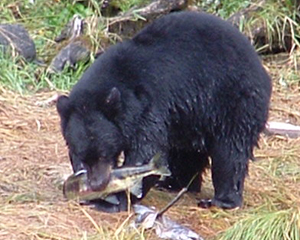 |
|---|
 |
In September some of the bears will begin moving away from the hatchery in search of blueberries and huckleberries. Other bears just keep eating salmon until the run is over - sometime in October. These bears can easily gain over one hundred pounds in just eight weeks. |
 |
|---|
 |
We named the little bear on the left "Patches". Last year Patches worked around the edge of the hatchery all summer long. Next year we expect Patches will begin mixing in with the bigger bears. |
 |
|---|
 |
Neets Bay is home to more than 200 harbor seals. Before we leave the bay we will stop and show you where they haul out on the rocks. Sea lions, like the ones swimming in the picture below, also come in to Neets Bay occasionally. They are much larger than harbor seals and can be very aggressive. |
 |
|---|
 |
 |
 |
|---|
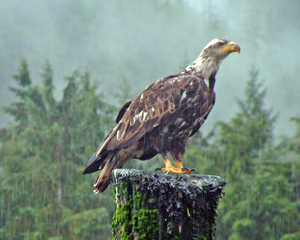 |
Bald eagles are also common in Neets Bay. Of course bald eagles are not really bald. They develop their characteristic white head feathers at age 4-5. You can tell the eagle on the left is 3-4 years old because its head feathers are just beginning to turn white. Although we cannot guarantee bear sightings on every trip, we have seen one or more bears on over 96% of these tours during the past 4 years. |
 |
|---|

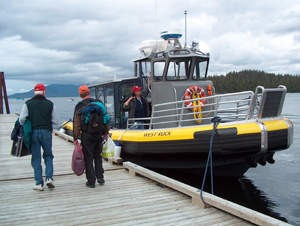 |
The Neets Bay Bear Cruise is provided aboard a 34 foot boat named the West Rock. The West Rock is powered by three 225 hp. outboard engines and travels at more than 30 knots. We provide binoculars, a light snack and a long raincoat. We ask that you dress warm. The West Rock has a comfortable restroom and covered seating for 13 people but it is not heated. |
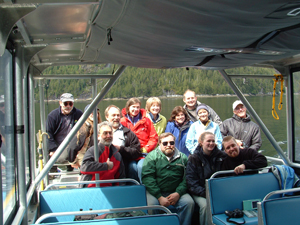 |
|---|
 |
Looking forward to seeing you! |
|
|---|